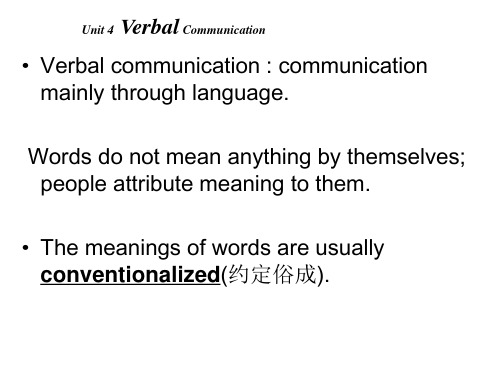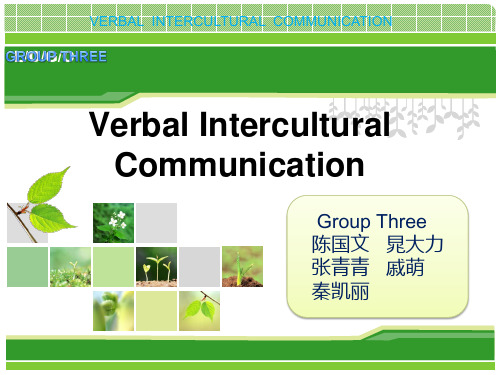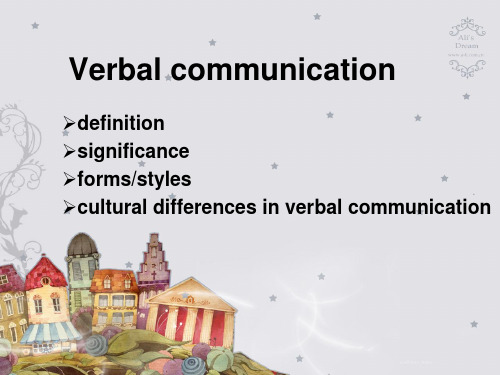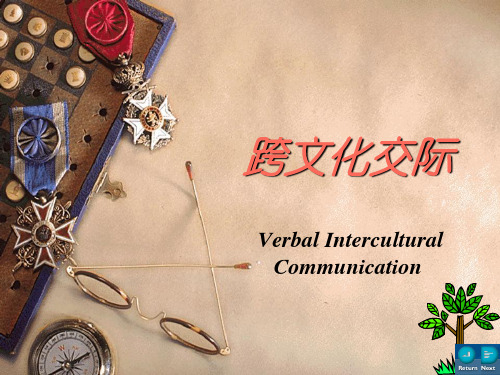chapter 8 Verbal Intercultural Communication
- 格式:ppt
- 大小:1.56 MB
- 文档页数:22





Chapter 1 CultureDefinitions:1 Culture is the deposit of knowledge, experience, beliefs, values, actions, attitudes, hierarchies, religions, notions of time, roles, spatial relations, concepts of the universe, and artifacts acquired by a group of people in the course of generations through individual and group striving. 文化是个人和群体在种族发展过程中所获得的知识、经验、信仰、价值观、行为、态度、阶级、宗教、时间观、角色、空间观、宇宙观和艺术品的集合。
(P12/P29)2 Cultural Identity refers to one’s sense of belonging to a particular culture or ethnic group.文化身份:认为自己归属于某一文化或民族群体的感觉。
(P19/29)3 Subculture exist within dominant cultures and are often based on economic or social class, ethnicity, race, or geographic region.指存在于主流文化中的文化,其划分通常基于经济地位、社会阶层、民族、种族或地理区域.(P23/29)4 Subgroups usually do not involve the same large number of people and are not necessarily thought of as accumulating values and patterns of behavior over generations in the same way as culture do.相对于亚文化和共文化群体,亚群体通常规模不大,也不一定有文化群体世代相传积累的价值观念和行为模式。

跨文化交际 Intercultural Communication智慧树知到课后章节答案2023年下内蒙古民族大学内蒙古民族大学绪论单元测试1.Foreigners are interested to learn about Chinese Culture and Chinese People.At the same time, there are misunderstandings of Chinese culture.A:错 B:对答案:对2.Overseas experiences can expand one's vision and enrich one'sunderstanding of Intercultural Communication.A:对 B:错答案:对3.Before communicating with others, you need to understand your own culturewell.A:错 B:对答案:对4.Culture learning is not so important as language learning.A:错 B:对答案:错5.Knowing all the words and having perfect grammar of a language is enoughto deal with Intercultural Communication.A:错 B:对答案:错6.Everything abroad is the same as “at home”.A:错 B:对答案:错7.In this course, we are going to learn aboutA:Intercultural communication barriers B:Verbal and non-verbalcommunication C:Thearatical foundations of Intercultural Communication D:Acquring Intercultural Communication Competence答案:Intercultural communication barriers;Verbal and non-verbalcommunication;Thearatical foundations of InterculturalCommunication;Acquring Intercultural Communication Competence8.In the study of intercultural communication, we are going to achieve thegoals ofA:understanding the basic termsB:developing communicative competence C:fostering critical thinking ofdifferent cultures D:avoiding potential problems in interculturalcommunication答案:understanding the basic terms;developing communicative competence;fostering critical thinking ofdifferent cultures;avoiding potential problems in interculturalcommunication9.The course you are taking isA:Phycology B:Communication C:Intercultural Communication D:EnglishLiterature答案:Intercultural Communication10.When being asked by other people about your culture, you will be moreaware of your identity.A:对 B:错答案:对第一章测试1.The dialogues at the United Nations, for example, would be termed _________.A:international communication B:interpersonal communication C:interracial communication D:interethnic communication答案:international communication2.In China, if a Tibetan communicates with a Han, it is _____.A:interracial communication B:international communication C:interethnic communication D:interpersonal communication答案:interethnic communication3._____ is the socialization process you go through to adapt to your society.A:Enculturation B:Deculturation C:Acculturation D:Assimilation答案:Enculturation4.Many of the same proverbs appear throughout the world, because all people,regardless of their culture, share common____.A:experiences B:stories C:languages D:arts答案:experiences5.In the popular cultural iceberg metaphor, you can only see about 10-15%above the surface, most part of the iceberg is under the water, which is a bit of a mystery. Which of the following do you think are above the water?A:clothing B:food C:architecture D:music答案:clothing;food;architecture ;music6.Six reasons of why study intercultural communication were mentioned,please try pick the ones mentioned in the following.A:technology B:imperative C:self-awarenessD:demographic changes答案:technology;imperative;self-awareness;demographic changes7.Culture can be categorized as either material or nonmaterial culture.A:对 B:错答案:对8.Culture is that complex whole whichincludes knowledge,belief,arts,morals,law,custom and any other capabilities and habits acquired by man as a member of society.A:对 B:错答案:对9.It is reasonable that we use what's below our surface to try to understandwhat's above somebody else’s.A:错 B:对答案:错10."Dig the well before you are thirsty" is a Chinese proverb meaning "吃水不忘挖井人”。
Chapter 1 CultureI.定义Culture(from intellectual perspective):从知性角度定义文化:作为整体的人类智力成就的艺术和其他表现Culture(from anthropologic perspective):从人类学角度定义文化:文化有清晰和模糊的行为模式构成,这些模式通过符号获得并传播,这些符号有人类群体的特别成就构成,包括具体的人工制品。
文化的基本核心由传统思想和与其相关的价值观构成。
Culture(from psychological perspective) : 从心理学角度定义文化:文化是使一个人类群体成员区别于其他人类群体的思维的总体规划。
Culture(from sociological perspective):从社会学角度定义文化:文化是一种可习得的,基于群体的认知模式——包括言语与非言语符号,态度,价值观,信仰和非信仰系统以及行为。
Culture(from intercultural communication perspective):从跨文化交际学角度定义文化:文化是个人和群体在种族发展过程中所获得的知识,经验,信仰,价值观,行为,态度,阶级,宗教,时间观,角色,空间观和艺术品的集合。
Culture Identity: 文化身份:认为自己归属于某一文化或民族群体的感觉。
Subculture亚文化:指存在于主流文化中的文化,其划分通常基于经济地位,社会阶层,民族,种族或地理区域。
Co-culture 共文化——指具有独特的交际特征,感知特点,价值观,信仰和行为,区别于其他群体,社团以及主流文化的群体或社团。
Subgroup 亚群体——相对于亚文化和共文化群体,亚群体通常规模不大,也不一定有文化群体时代相传积累的价值观念和行为模式。
Chapter 2 Communication and Intercultural Communication1. Sender/Source信息发出者/信息源:指传递信息的人2. Message信息:只引起信息接受者反应的任何信号。